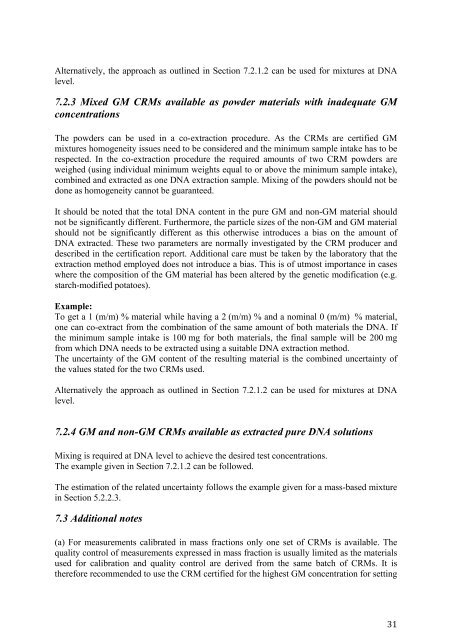final%20report%20online%20upd
final%20report%20online%20upd
final%20report%20online%20upd
Create successful ePaper yourself
Turn your PDF publications into a flip-book with our unique Google optimized e-Paper software.
Alternatively, the approach as outlined in Section 7.2.1.2 can be used for mixtures at DNA<br />
level.<br />
7.2.3 Mixed GM CRMs available as powder materials with inadequate GM<br />
concentrations<br />
The powders can be used in a co-extraction procedure. As the CRMs are certified GM<br />
mixtures homogeneity issues need to be considered and the minimum sample intake has to be<br />
respected. In the co-extraction procedure the required amounts of two CRM powders are<br />
weighed (using individual minimum weights equal to or above the minimum sample intake),<br />
combined and extracted as one DNA extraction sample. Mixing of the powders should not be<br />
done as homogeneity cannot be guaranteed.<br />
It should be noted that the total DNA content in the pure GM and non-GM material should<br />
not be significantly different. Furthermore, the particle sizes of the non-GM and GM material<br />
should not be significantly different as this otherwise introduces a bias on the amount of<br />
DNA extracted. These two parameters are normally investigated by the CRM producer and<br />
described in the certification report. Additional care must be taken by the laboratory that the<br />
extraction method employed does not introduce a bias. This is of utmost importance in cases<br />
where the composition of the GM material has been altered by the genetic modification (e.g.<br />
starch-modified potatoes).<br />
Example:<br />
To get a 1 (m/m) % material while having a 2 (m/m) % and a nominal 0 (m/m) % material,<br />
one can co-extract from the combination of the same amount of both materials the DNA. If<br />
the minimum sample intake is 100 mg for both materials, the final sample will be 200 mg<br />
from which DNA needs to be extracted using a suitable DNA extraction method.<br />
The uncertainty of the GM content of the resulting material is the combined uncertainty of<br />
the values stated for the two CRMs used.<br />
Alternatively the approach as outlined in Section 7.2.1.2 can be used for mixtures at DNA<br />
level.<br />
7.2.4 GM and non-GM CRMs available as extracted pure DNA solutions<br />
Mixing is required at DNA level to achieve the desired test concentrations.<br />
The example given in Section 7.2.1.2 can be followed.<br />
The estimation of the related uncertainty follows the example given for a mass-based mixture<br />
in Section 5.2.2.3.<br />
7.3 Additional notes<br />
(a) For measurements calibrated in mass fractions only one set of CRMs is available. The<br />
quality control of measurements expressed in mass fraction is usually limited as the materials<br />
used for calibration and quality control are derived from the same batch of CRMs. It is<br />
therefore recommended to use the CRM certified for the highest GM concentration for setting<br />
31
















